Kinematics | Physics - Long Questions and Answer | 11th Physics : UNIT 2 : Kinematics
Chapter: 11th Physics : UNIT 2 : Kinematics
Long Questions and Answer
Physics : Kinematics
Long Answer Questions
1. Explain in detail the triangle law of addition.

●
The two vectors are represented by two adjacent sides of a triangle taken in
the same order. Then the resultant is given by the third side of the triangle.
●
The head of the first vector ![]() is connected to the tail of second
vector
is connected to the tail of second
vector ![]() .
.
●
Let θ is the angle between ![]() and
and ![]() .
.
●
R is the resultant vector connecting the tail of the first vector ![]() to
the head of the second vector
to
the head of the second vector ![]() .
.
● 
1)
Magnitude of resultant Vector :

●
Consider the triangle ABN which is obtained by extending the side OA to ON.
●
ABN is a right angled triangle.
cos
θ = AN / B
∴ AN = B cos θ ……… (1)
cos
θ = BN / B
∴ AN = B cos θ ……… (2)
For
∆ OBN, OB2 = ON2 + BN2 ……… (3)
R2
= (A+B cosθ)2 + (B sinθ)2
R2
= A2 + B2 cos2θ + 2AB cos + B2sin2θ
R2
= A2 + B2 (cos2θ sin2θ) + 2AB cosθ
R2
= A2 + B2 + 2AB cosθ
R
= √[A2 + B2 + 2AB cosθ] ………… (4)
2.
Direction of resultant Vectors :
If θ is the angle between ![]() and
and ![]() , then
, then
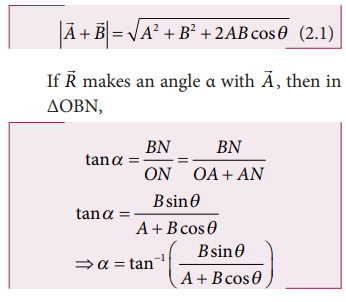
In
∆OBN
tan
α = BN / ON = BN / (OA + AN)
tan
α = Bsinθ / (A + B cosθ)
∴
α
= tan-1 (Bsinθ / [A + B cosθ])
……….(6)
2. Discuss the properties of scalar and vector products.
Properties
of scalar Product:
(i)
The product quantity ![]() .
. ![]() is always a scalar. It is positive
if the angle between the vectors is acute and negative if the angle between
them is obtuse.
is always a scalar. It is positive
if the angle between the vectors is acute and negative if the angle between
them is obtuse.
(ii)
The scalar product is commutative
![]() .
. ![]() =
= ![]() .
. ![]()
(iii)
The vectors obey distributive law i,e,

(iv) The angle between the vectors

(v)
The scalar product of two vectors will be maximum when cosθ = 1 i.e. θ = 0°
When the vectors are parallel (![]() .
.![]() )max = AB
)max = AB
(vi)
The scalar product of two vectors will be minimum when cosθ = −1 i.e. θ = 180°
.
(![]() .
. ![]() )mini = −AB when the
vectors are anti parallel.
)mini = −AB when the
vectors are anti parallel.
vii)
If the vectors ![]() and
and ![]() are perpendicular to each other then their
scalar product
are perpendicular to each other then their
scalar product ![]() .
. ![]() = 0. Then the vectors
= 0. Then the vectors ![]() and
and ![]() are said to be mutually orthogonal.
are said to be mutually orthogonal.
viii)
The scalar product of a vector with itself is termed as self dot product and is
given by

The
magnitude (or) norm of the vectors ![]() is |
is |![]() | = A = √{
| = A = √{![]() .
.![]() }
}
ix) In the case of a unit vector n^

x)
In the case of orthogonal unit vectors i^, j^ and k^

Properties
of vector product:
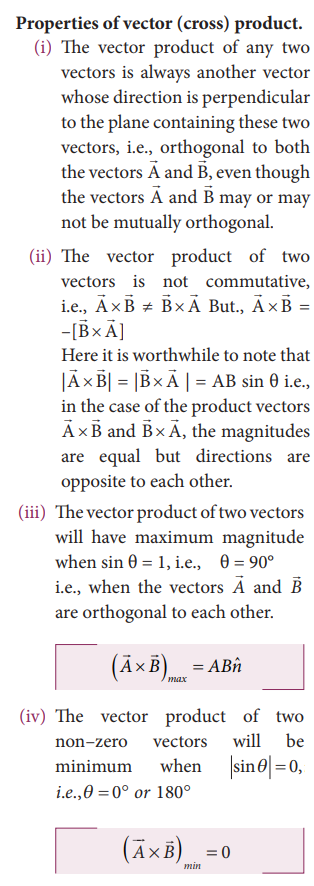


3. Derive the kinematic equations of motion for constant acceleration.
●
Consider an object moving in a straight line with uniform constant
acceleration.
●
Let u be the velocity of the object at time t = 0.
●
v be the velocity of the body at a time t.
Velocity
- time relation :
i)
The acceleration of the body at any instant is given by the first derivative of
velocity with respect to time.
a
= dv / dt (or) dv = a.dt ……. (1)
Integrating
on both sides

[v]uv
= a [t]0t
v
– u = at
v = u + at ……..(2)
Displacement
- time relation :
ii)
The velocity of the body is given by the first derivative of the displacement
with time.
v
= ds / dt
ds
= v.dt …………….(3)
since
v = u+at
ds
= (u+at) dt ……………. (4)
intergrating
on both sides
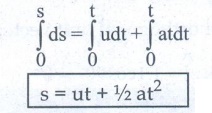
s = ut + ½ at2 …………(5)
Velocity
- displacement relation:
iii)
The acceleration is given by the first derivative of velocity with respect to
time.
a
= dv / dt = dv/ds . ds/dt = v . dv/ds (ds / dt = v)
a
= ½ dv2/ds
ds
= 1/2a d(v2) ………..(6)
Integrating
on both sides

∴ s = 1/2a
(v2 – u2)
v2 = u2 + 2as …………(7)
From
equation
at
= v - u …………….
(8)
Substitute
equation (8) in equation (5) we get,
s
= ut+ ½ (v-u) t
s = [(u+v)t] / 2 …………(9)
Kinematic
equations,
v
= u+at
s
= ut+ ½ at2
v2
= u2 + 2as
s
= [(u+v)t ] / 2
4. Derive the equations of motion for a particle (a) falling vertically (b) projected vertically
i)
A body falling vertically from a height h:
●
Consider an object of mass in falling from a height h.
●
Let us choose the downward direction as positive y axis.
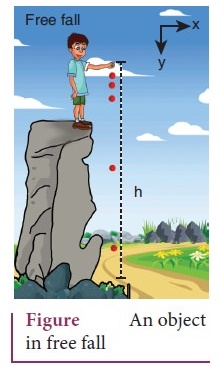
●
The object experience acceleration 'g' due to granty which is constant near the
surface of the earth. The acceleration 
By
comparing the components we get, ax =0, az =0, ay =
g
ay
= a = g
●
If the particle is thrown with initial velocity u downward which is in negative
y axis.
●
Then velocity and position of the particle at any time t is given by,
v
= u + gt …….......
(1)
y
= ut + ½ gt2 .......... (2)
The
square of the speed of the particle is
v2
= u2 + 2gy ......... (3)
Suppose
the particle starts from rest
Then
u = 0
v
= gt ..........
(4)
y
= ½ gt2 .......... (5)
v2 = 2gy .......... (6)
b)
A body thrown vertically upwards :
●
An object of mass m thrown vertically up-wards with an initial velocity u.
●
The acceleration a = −g and g points towards the negative y axis.
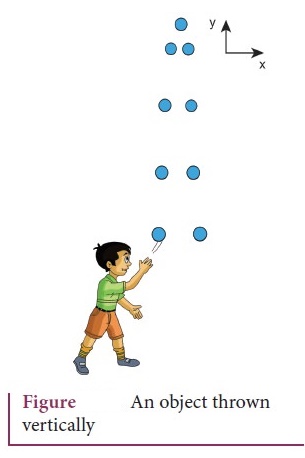
●
The Kinematic equations for this motion are
v
= u − gt ……….
(7)
s
= ut – ½ gt2 ………. (8)
v2
= u2 -2gy
5. Derive the equation of motion, range and maximum height reached by the particle thrown at an oblique angle θ with respect to the horizontal direction.
●
Consider an object thrown with initial velocity ![]() u at an angle θ with
the horizontal.
u at an angle θ with
the horizontal.
Then 
Where
ux = u cos θ is the horizontal component.
uy
= u sinθ is the vertical component of velocity.
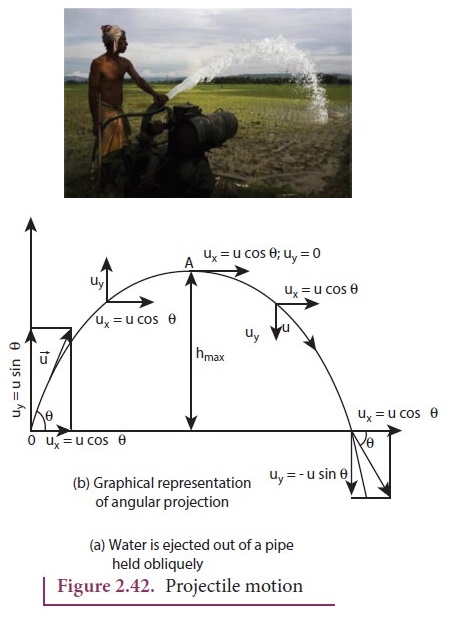
After
the time t1 the velocity along horizontal motion
vx
= u + ax
t
= ux = u cosθ
The
horizontal distance is
sx
= uxt + ½axt2
Here
sx = x, ux = u cosθ, ax = 0
x
= u cosθ.t
t
= x / ucosθ ………..(1)
For
vertical motion vy = uy + ayt
Here
uy = u sinθ, ay = −g
vy
= u sinθ – gt ………(2)
The
vertical distance travelled by the projectile is
sy
= uyt + ½ ay t2
Here
sy = y, uy = u sinθ, ax = −g
than
y = u sinθ.t – ½ gt2 ………(3)
Substitute
the 't' value from the equation (1) in equation (3), we have
y
= u sinθ [ x / ucosθ ] – ½ g [ x2 / u2 cos2θ
] ………(4)
The
path followed by the projectile is an inverted parabola.
Maximum
(hmax )
The
maximum vertical distance travelled by projectile during its journey is called
maximum height.
For
vertical part of motion,
v2y
= u2y + 2ayS
Here,
uy = u sinθ, ay = −g, s = hmax ; vy
= 0
O
= u2sin2 θ − 2ghmax
hmax = u2sin2θ / 2g
 …………(5)
…………(5)
Horizontal
Range (R):
The
maximum horizontal distance between the point of projection and the point on
the horizontal plane where the projectile hits the ground is called horizontal
range (R).
Range
R = Horizontal compoent of velocity × time of flight
R
= u cosθ × Tf
R
= ucosθ × [2u sinθ / g] = [ 2u2 sinθ cosθ ] / g
R = [u2 sin2θ] / g
 ……………… (6)
……………… (6)
The
maximum possible range is reached when sin2θ = l,
When 2θ = π /2 (or) θ = π /4
Rmax = u2 / g
 …………..(7)
…………..(7)
6. Derive the expression for centripetal acceleration.
●
The acceleration acting on an object towards the center of the circle in a
uniform circular motion is known as centripetal acceleration.
●
The centripetal acceleration is derived from a simple relationship between
position and velocity vector.
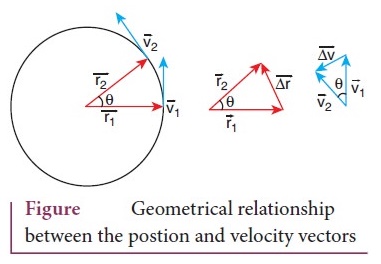
●
The directions of position and velocity vectors shift through the same angle θ
in small time ∆t as shown in the above figure
●
For uniform circular motion r = | ![]() | = |
| = | ![]() | and v = |
| and v = | ![]() | = |
| = | ![]() |
|
●
If the particle moves from position vector ![]() to
to ![]()
●
The displacement 
●
Then change in velocity 
then
∆r/r = - ∆v/v = θ …………. (1)
Here
negative sign implies that ∆v points radially inward, towards the centre of the
circle.
∆v
= −v (∆r / r)
a
= ∆v / ∆t = v/r (∆r / ∆t) = −v2 / r
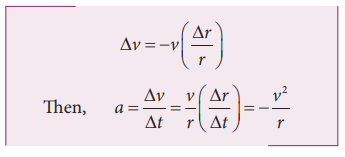
For
uniform circular motion v = rω
Then centripetal acceleration a = −v2 / r = - ω2r

7. Derive the expression for total acceleration in the non uniform circular motion.
●
If the speed of the object in circular motion is not constant then it is called
non-uniform motion.
Example
: The bob attached to a string moves in vertical circle.
●
The speed of the bob is not the same at all time.
●
The speed is not same in circular motion, the particle will have both
centripetal and tangetial acceleration.
The
centripetal acceleration is v2/r
The magnitude of resultant acceleration is
aR
= √ [ at2 + (v2 / r)2 ]

The
resultant acceleration makes an angle θ with the radius vector.
The
angle is given by tan θ = at / (v2 / r)

Related Topics